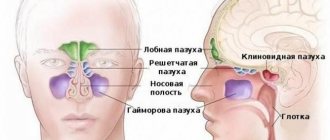Causes Symptoms characteristic of the presence of sulfur plugs Diagnosis | Treatment of wax plugs Prevention of wax plugs formation
In the external auditory canal, in the thickness of the skin, there are special glands (cerumin), necessary for the secretion of a specific substance - earwax. The main function of this secretion is protective, which includes antibacterial, antiviral and mechanical mechanisms. In the latter case, earwax, due to its adhesive property, traps dust, preventing them from penetrating deeper.
Earwax is constantly produced in the external auditory canal, and its surface layer, contaminated with dust, microbes and other particles, gradually dries out and falls out along with the scales of the skin epidermis. The process of self-cleaning of the ear from “waste” wax is also facilitated by passive vibrations of the cartilage of the external auditory canal during movement in the lower jaw (chewing, talking, yawning).
If the natural process of removing sulfur is difficult, then sulfur plugs occur. They are also formed due to improper ear hygiene.
Thus, cerumen plug is a blockage of the external auditory canal with a mass consisting of dry earwax, desquamated epithelium and dust particles.
You can diagnose and treat wax plugs in the Otorhinolaryngology Department K+31.
Causes
The presence of wax plugs in the ears is a fairly common phenomenon, and this is due to a large number of reasons:
- Improper hygiene of the outer ear, which consists of using cotton swabs and pushing wax deep into the external auditory canal;
- Increased secretion of earwax due to too frequent removal;
- Metabolic disorders and especially cholesterol disorders can stimulate the production of sulfur;
- Work in conditions of high dust content in the air (construction dust, flour);
- High humidity in the room or frequent entry of water into the ear contributes to the swelling of wax and blocking of the ear canal;
- Too dry air makes it difficult for spontaneous removal of sulfur and leads to its compaction and the appearance of a plug.
The formation of cerumen plug is observed when the natural evacuation of cerumen is disrupted due to pathology of the temporomandibular joint, narrowing or curvature of the external auditory canal.
How to remove a plug from your ear
- rinse with water. Water is drawn into a special syringe and the stream is directed into the ear canal. Water pressure flushes wax out of the ear. It does not hurt. Sometimes multiple treatments are required;
- pull out with tweezers. Only an otolaryngologist removes the plug in this way. He has special devices: tweezers or a hook. With the help of them, he carefully removes the sulfur. The method is used for damaged membrane;
- drop drops. There are drops that dissolve sulfur. They are buried in the ear and wait until the substance takes effect. This takes a few minutes. After which the person tilts his head and the sulfur along with the drops flows out. You can instill it at home or at the doctor's office. The method is suitable for small children, as it is difficult for them to sit still for a long time;
- remove with heat. A person lies with his ear on a heating pad. The water in it should not be hot. Otherwise you might get burned. The heat softens the wax and leaves the ear. If you don’t have a heating pad, you can take a plastic bottle with warm liquid;
- blow out your ear. Take a deep breath and hold the air. Pinch your nose, cover your mouth and exhale sharply. Air will enter the ear canal through the Eustachian tube and push the plug towards the exit;
- use ear candles. Pharmacies sell candles to remove wax. They contain beeswax and propolis. The procedure can be carried out at home, but very carefully. An assistant will be needed. Insert the candle into your ear and light it. While the candle burns, a vacuum is created in the ear, which will push the wax out.
Regardless of the removal method, be prepared for a side effect - temporary hearing loss. Any intervention causes swelling. Because of it, the ear canal narrows and the person hears worse.
Symptoms characteristic of the presence of sulfur plugs
Most often, wax plugs in the ears form over a long period of time . At the very beginning of its occurrence, no subjective sensations are noted, and only when the ear canal is blocked by more than 50% do the first symptoms appear in the form of congestion in the ear and hearing loss.
As the plug gets larger, these symptoms become more pronounced. Complete blockage of the external auditory canal significantly impairs hearing on the corresponding side. In addition, the pressure on the eardrum changes, which leads to:
- Noise in the ears;
- Reflection (resonance) of one’s own voice in the ear;
- Vestibular disorders (dizziness, imbalance);
- Neuralgia (dull pain in the ear, headache);
- Emotional and mental disorders.
With the long-term presence of cerumen, the likelihood of inflammatory processes in the external (otitis externa) and middle ear (chronic otitis media) increases.
Helpful information
The main symptom of wax impaction is hearing loss. If you try to remove wax on your own by washing it out, you will most likely achieve the opposite effect: your ears will become even more clogged, and you will temporarily stop hearing. The fact is that when water gets into the ear, the wax swells and completely blocks the ear canal.
Other symptoms are also possible:
•headache;
•high temperature;
•nausea.
Pain occurs when an ear plug in the ear canal puts pressure on the eardrum and irritates the nerve endings. If these signs occur, immediately consult an otolaryngologist.
Long-term exposure to nerve cells disrupts the functioning of the entire nervous system and provokes an inflammatory process. And inflammation of the hearing organs is extremely dangerous due to its proximity to brain tissue. Due to the fact that the inflammatory process easily spreads to neighboring organs, there is always a risk of death.
What does wax plug look like?
It is easy to understand that there is a plug in the ear: it is visible to the naked eye, the plug is brown or yellow in color, and can be pasty or dry and dense.
Ways to remove wax plug
So what to do if there is a plug in the ear canal? First of all, consult a doctor. You can find many tips on the Internet for removing ear plugs at home. But if you are not a fan of experimenting with your health (and especially with your child’s health!), think about whether it’s worth following them.
There is always a risk of damaging the thin eardrum or causing permanent hearing loss. Remember: Q-tips are not meant to remove ear plugs!
If there is a plug in the ear, removal is done in a doctor's office. The otorhinolaryngologist uses a syringe: draws up saline solution and, under pressure, flushes out the plugs from the patient’s ear. The procedure does not last long and does not leave any unpleasant sensations.
In some cases, ear rinsing is contraindicated (this is another reason not to try it yourself). If the formation of ear plugs is caused by purulent otitis, then the fluid in the ear canal is a direct threat to hearing.
If it is impossible to rinse the ear, use the dry method. Using a special instrument (hook probe), a hole is made in the ear plug and wax is removed through it.
The choice of method is made by the doctor during the initial appointment. He conducts a visual examination of the patient’s outer ear, collects anamnesis, clarifies the signs of the disease and concomitant diseases, and, if necessary, conducts a full diagnosis. Establishing the exact reasons for the formation of plugs in the ear is the only way to exclude the presence of contraindications.
Usually, in order to remove wax plug, just one visit to a specialist is enough. But if the plug in the ear is dry and hard and cannot be easily washed out (and this usually happens when the patient puts off seeing a doctor for a long time), you will have to come to the ENT office again. In such cases, instillation of a solution of hydrogen peroxide (or other specialized drugs) into the ear for several days is indicated. After the plug has softened, the standard ear rinsing procedure is applied.
On the modern drug market, “new generation products” have been offered that allow you to dissolve the sulfur plug. But they should be used with caution due to the presence of contraindications (for example, use for children under 2.5 years is prohibited). Since the effectiveness of these drugs remains low (dissolution occurs in approximately 70% of cases and sulfur masses rarely dissolve completely), ENT doctors prefer not to use them.
Causes of wax plugs in the ears
The formation of wax in the ear canal is a natural process during the normal functioning of the human body. Self-cleaning of excess wax from the ears also occurs naturally. This happens when the temporomandibular joint moves: when you speak, swallow, chew, excess wax is pushed out of the ear canal. Congestion occurs when there is increased production of wax in the outer ear and difficulty in self-cleaning.
They can lead to:
•increased secretory activity of the sulfur glands;
•improper ear hygiene;
•frequent inflammatory diseases of the hearing organs;
•anatomical features of the external ear and auditory canal;
•low air humidity.
Overproduction of earwax is associated with any disturbances in the functioning of the body - you should contact a professional for examination and identification of these disturbances. The formation of wax accumulations may be associated with the anatomical features of the ear: for example, if the ear canal has a narrow, tortuous shape. In all other cases, following simple preventive measures helps prevent wax from accumulating in the ear canal.
Preventing the formation of wax plugs in the ears
1. Take proper care of your ears. Cotton swabs can only be used to clean the outside of the ear; do not even try to penetrate the ear canal with them. You will only push the sulfur masses deeper and “compact” them there. But this does not mean that ears do not require hygiene. You should wash your ears with soapy water, clean the space above the tragus (the so-called cartilaginous protrusion at the base of the ear);
2. Be careful with ENT diseases, always contact specialists for help in a timely manner. Any inflammatory process of the ear, nose and throat must be stopped as quickly as possible;
3. Monitor the humidity of the room. This advice is especially relevant when it comes to a child’s room. Dry air can provoke the constant formation of sulfur plugs.
Diagnostics
Diagnosis of wax plug is quite simple. To do this, you need to contact an otolaryngologist, who will determine the pathology with a simple otoscopy. During the examination, the external auditory canal is examined using a special ear specula. The presence of cerumen is indicated by a yellow or brown mass that completely covers the ear canal and eardrum. Large neglected sulfur plugs can be seen with the naked eye.
Diagnosis is aided by the patient's characteristic complaints, examination of ear hygiene, information about previous diseases, and laboratory tests.
Prevention
To prevent wax plugs you should:
- carefully carry out ear hygiene measures;
- cover your ears when staying in a dusty room for a long time;
- treat concomitant skin and metabolic diseases;
- undergo preventive examinations with an otolaryngologist.
SM-Clinic specialists point out that this disease can lead to inflammatory changes in the middle ear and gradual loss of hearing function. Seeing a doctor at the first symptoms will help prevent this.
Treatment of wax plug
Removal of wax plugs should only be carried out under the guidance of an experienced otolaryngologist.
Old-timers of the first medical institute remember the case when cerumen was given to the entire staff of the clinic for two weeks! Almost all employees contributed, from interns and subordinates to the head of the department. As a result, the plug was removed. The name of the winner has not been preserved in history.
The method of removing the plug is selected based on the neglect of the process. Soft and pasty wax plugs are removed by routinely flushing the outer ear with warm water under pressure. For this, a syringe without a needle, a syringe, etc. is used.
Dry and hard sulfur plugs require initial softening (using hydrogen peroxide or cerumen) followed by washing.
Plugs that cannot be softened can be removed with a special medical instrument.
Functions of earwax
Earwax contains the following components: secretions secreted by the skin glands in the ear, a small amount of sweat, fat, cholesterol, substances with antibacterial properties, fatty acids and desquamated epithelial cells.
Earwax performs the following functions:
- protects the ear canal from dirt and pathogenic microflora;
- prevents fungal and infectious diseases, preventing microorganisms from multiplying;
- ensures the removal of dead epithelium from the ear;
- protects the skin of the ear from the irritating effects of water;
- prevents dehydration of the skin in the ear canal;
- provides support for normal acid-base balance.
In a healthy body, excess earwax is removed due to the physiological characteristics of the ear canal.
Preventing the formation of wax plugs
To prevent the formation of wax plugs in the ears, otorhinolaryngologists at K+31 Clinic offer some simple tips:
- Proper ear care: for this you need to regularly wash the auricle with soap, the external auditory canal is washed only to the depth of the little finger, and cotton swabs are used only on the outside;
- Limiting harmful environmental influences: reducing the time spent in dusty, high humidity or excessively dry areas.
- Timely treatment of diseases of the ear, temporomandibular joint and other pathologies that worsen the spontaneous evacuation of earwax or increase its secretion.
Following these rules will help avoid the formation of sulfur plugs and will keep you healthy.
Treatment
Treatment of this disease is carried out using several methods:
- by washing - if the sulfur plug is of a soft consistency, then it can be washed out with a warm aqueous solution. To do this, the liquid is injected into the ear cavity under pressure using a Janet syringe;
- aspiration (suction) with an electric suction – also suitable for soft sulfur masses;
- curettage – removal of the ear plug with a special probe;
- removal by dissolution method - for this, ear drops are used to help soften and dissolve earwax.









